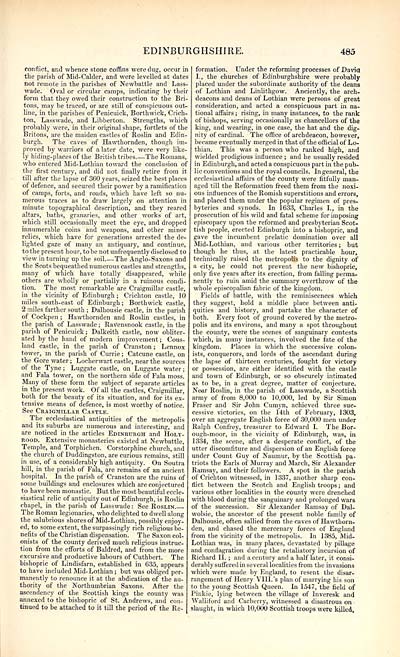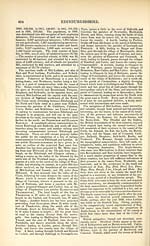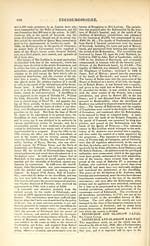Topographical, statistical, and historical gazetteer of Scotland > Volume 1
(577) Page 485
Download files
Complete book:
Individual page:
Thumbnail gallery: Grid view | List view

EDINBURGHSHIRE.
485
conflict, and whence stone coffins were dug, occur in
the parish of Mid-Calder, and were levelled at dates
not remote in the parishes of Newbattle and Lass-
wade. Oval or circular camps, indicating by their
form that they owed their construction to the Bri-
tons, may be traced, or are still of conspicuous out-
line, in the parishes of Penicuick, Borthwick, Crich-
ton, Lasswade, and Libberton. Strengths, which
probably were, in their original shape, fortlets of the
Britons, are the maiden castles of Roslin and Edin-
burgh. The caves of Hawthornden, though im-
proved by warriors of a later date, were very like-
ly hiding-places of the British tribes The Romans,
who entered Mid-Lothian toward the conclusion of
the first century, and did not finally retire from it
till after the lapse of 360 years, seized the best places
of defence, and secured their power by a ramification
of camps, forts, and roads, which have left so nu-
merous traces as to draw largely on attention in
minute topographical description, and they reared
altars, baths, granaries, and other works of art,
which still occasionally meet the eye, and dropped
innumerable coins and weapons, and other minor
relics, which have for generations arrested the de-
lighted gaze of many an antiquary, and continue,
to the present hour, to be not unfrequently disclosed to
view in turning up the soil The Anglo-Saxons and
the Scots bequeathed numerous castles and strengths,
many of which have totally disappeared, while
others are wholly or partially in a ruinous condi-
tion. The most remarkable are Craigmillar castle,
in the vicinity of Edinburgh ; Crichton castle, 10
miles south-east of Edinburgh ; Borthwick castle,
2 miles farther south ; Dalhousie castle, in the parish
of Cockpen ; Hawthornden and Roslin castles, in
the parish of Lasswade ; RaVensnook castle, in the
parish of Penicuick ; Dalkeith castle, now obliter-
ated by the hand of modern improvement ; Cous-
land castle, in the parish of Cranston ; Lennox
tower, in the parish of Currie ; Catcune castle, on
the Gore water; Locherwart castle, near the sources
of the Tyne ; Luggate castle, on Luggate water ;
and Fala tower, on the northern side of Fala moss.
Many of these form the subject of separate articles
in the present work. Of all the castles, Craigmillar,
both for the beauty of its situation, and for its ex-
tensive means of defence, is most worthy of notice.
See Craigmillar Castle.
The ecclesiastical antiquities of the metropolis
and its suburbs are numerous and interesting, and
are noticed in the articles Edinburgh and Holt-
rood. Extensive monasteries existed at Newbattle,
Temple, and Torphichen. Corstorphine church, and
the church of Duddingston, are curious remains, still
in use, of a considerably high antiquity. On Soutra
hill, in the parish of Fala, are remains of an ancient
hospital. In the parish of Cranston are the ruins of
some buildings and enclosures which are conjectured
to have been monastic. But the most beautiful eccle-
siastical relic of antiquity out of Edinburgh, is Roslin
chapel, in the parish of Lasswade : See Roslin
The Roman legionaries, who delighted to dwell along
the salubrious shores of Mid-Lothian, possibly enjoy-
ed, to some extent, the surpassingly rich religious be-
nefits of the Christian dispensation. The Saxon col-
onists of the county derived much religious instruc-
tion from the efforts of Baldred, and from the more
excursive and productive labours of Cuthbert. The
bishopric of Lindisfarn, established in 635, appears
to have included Mid-Lothian ; but was obliged per-
manently to renounce it at the abdication of the au-
thority of the Northumbrian Saxons. After the
ascendency of the Scottish kings the county was
annexed to the bishopric of St. Andrews, and con-
tinued to be attached to it till the period of the Re-
formation. Under the reforming processes of Davia
I., the churches of Edinburghshire were probably
placed under the subordinate authority of the deans
of Lothian and Linlithgow. Anciently, the arch-
deacons and deans of Lothian were persons of great
consideration, and acted a conspicuous part in na-
tional affairs ; rising, in many instances, to the rank
of bishops, serving occasionally as chancellors of the
king, and wearing, in one case, the hat and the dig-
nity of cardinal. The office of archdeacon, however,
became eventually merged in that of the official of Lo-
thian. This was a person who ranked high, and
wielded prodigious influence ; and he usually resided
in Edinburgh, and acted a conspicuous part in the pub-
lic conventions and the royal councils. In general, the
ecclesiastical affairs of the county were fitfully man-
aged till the Reformation freed them from the noxi-
ous influences of the Romish superstitions and errors,
and placed them under the popular regimen of pres-
byteries and synods. In 1633, Charles I., in the
prosecution of his wild and fatal scheme for imposing
episcopacy upon the reformed and presbyterian Scot-
tish people, erected Edinburgh into a bishopric, and
gave the incumbent prelatic domination over all
Mid-Lothian, and various other territories ; but
though he thus, at the latest practicable hour,
technically raised the metropolis to the dignity of
a city, he could not prevent the new bishopric,
only five years after its erection, from falling perma-
nently to ruin amid the summary overthrow of the
whole episcopalian fabric of the kingdom.
Fields of battle, with the reminiscences which
they suggest, hold a middle place between anti-
quities and history, and partake the character of
both. Every foot of ground covered by the metro-
polis and its environs, and many a spot throughout
the county, were the scenes of sanguinary contests
which, in many instances, involved the fate of the
kingdom. Places in which the successive colon-
ists, conquerors, and lords of the ascendant during
the lapse of thirteen centuries, fought for victory
or possession, are either identified with the castle
and town of Edinburgh, or so obscurely intimated
as to be, in a great degree, matter of conjecture.
Near Roslin, in the parish of Lasswade, a Scottish
army of from 8,000 to 10,000, led by Sir Simon
Fraser and Sir John Cumyn, achieved three suc-
cessive victories, on the 14th of February, 1303,
over an aggregate English force of 30,000 men under
Ralph Confrey, treasurer to Edward I. The Bor-
ough-moor, in the vicinity of Edinburgh, was, in
1334, the scene, after a desperate conflict, of the
utter discomfiture and dispersion of an English force
under Count Guy of Naumur, by the Scottish pa-
triots the Earls of Murray and March, Sir Alexander
Ramsay, and their followers. A spot in the parish
of Crichton witnessed, in 1337, another sharp con-
flict between the Scotch and English troops ; and
various other localities in the county were drenched
with blood during the sanguinary and prolonged wars
of the succession. Sir Alexander Ramsay of Dal-
wolsie, the ancestor of the present noble family of
Dalhousie, often sallied from the caves of Hawthorn-
den, and chased the mercenary forces of England
from the vicinity of the metropolis. In 1385, Mid-
Lothian was, in many places, devastated by pillage
and conflagration during the retaliatory incursion of
Richard II. ; and a century and a half later, it consi-
derably suffered in several localities from the invasions
which were made by England, to resent the disar-
rangement of Henry VIII. 's plan of marrying his son
to the young Scottish Queen. In 1547, the field of
Pinkie, lying between the village of Inveresk and
Walliford and Carberry, witnessed a disastrous on
slaught, in which 10,000 Scottish troops were killed.
485
conflict, and whence stone coffins were dug, occur in
the parish of Mid-Calder, and were levelled at dates
not remote in the parishes of Newbattle and Lass-
wade. Oval or circular camps, indicating by their
form that they owed their construction to the Bri-
tons, may be traced, or are still of conspicuous out-
line, in the parishes of Penicuick, Borthwick, Crich-
ton, Lasswade, and Libberton. Strengths, which
probably were, in their original shape, fortlets of the
Britons, are the maiden castles of Roslin and Edin-
burgh. The caves of Hawthornden, though im-
proved by warriors of a later date, were very like-
ly hiding-places of the British tribes The Romans,
who entered Mid-Lothian toward the conclusion of
the first century, and did not finally retire from it
till after the lapse of 360 years, seized the best places
of defence, and secured their power by a ramification
of camps, forts, and roads, which have left so nu-
merous traces as to draw largely on attention in
minute topographical description, and they reared
altars, baths, granaries, and other works of art,
which still occasionally meet the eye, and dropped
innumerable coins and weapons, and other minor
relics, which have for generations arrested the de-
lighted gaze of many an antiquary, and continue,
to the present hour, to be not unfrequently disclosed to
view in turning up the soil The Anglo-Saxons and
the Scots bequeathed numerous castles and strengths,
many of which have totally disappeared, while
others are wholly or partially in a ruinous condi-
tion. The most remarkable are Craigmillar castle,
in the vicinity of Edinburgh ; Crichton castle, 10
miles south-east of Edinburgh ; Borthwick castle,
2 miles farther south ; Dalhousie castle, in the parish
of Cockpen ; Hawthornden and Roslin castles, in
the parish of Lasswade ; RaVensnook castle, in the
parish of Penicuick ; Dalkeith castle, now obliter-
ated by the hand of modern improvement ; Cous-
land castle, in the parish of Cranston ; Lennox
tower, in the parish of Currie ; Catcune castle, on
the Gore water; Locherwart castle, near the sources
of the Tyne ; Luggate castle, on Luggate water ;
and Fala tower, on the northern side of Fala moss.
Many of these form the subject of separate articles
in the present work. Of all the castles, Craigmillar,
both for the beauty of its situation, and for its ex-
tensive means of defence, is most worthy of notice.
See Craigmillar Castle.
The ecclesiastical antiquities of the metropolis
and its suburbs are numerous and interesting, and
are noticed in the articles Edinburgh and Holt-
rood. Extensive monasteries existed at Newbattle,
Temple, and Torphichen. Corstorphine church, and
the church of Duddingston, are curious remains, still
in use, of a considerably high antiquity. On Soutra
hill, in the parish of Fala, are remains of an ancient
hospital. In the parish of Cranston are the ruins of
some buildings and enclosures which are conjectured
to have been monastic. But the most beautiful eccle-
siastical relic of antiquity out of Edinburgh, is Roslin
chapel, in the parish of Lasswade : See Roslin
The Roman legionaries, who delighted to dwell along
the salubrious shores of Mid-Lothian, possibly enjoy-
ed, to some extent, the surpassingly rich religious be-
nefits of the Christian dispensation. The Saxon col-
onists of the county derived much religious instruc-
tion from the efforts of Baldred, and from the more
excursive and productive labours of Cuthbert. The
bishopric of Lindisfarn, established in 635, appears
to have included Mid-Lothian ; but was obliged per-
manently to renounce it at the abdication of the au-
thority of the Northumbrian Saxons. After the
ascendency of the Scottish kings the county was
annexed to the bishopric of St. Andrews, and con-
tinued to be attached to it till the period of the Re-
formation. Under the reforming processes of Davia
I., the churches of Edinburghshire were probably
placed under the subordinate authority of the deans
of Lothian and Linlithgow. Anciently, the arch-
deacons and deans of Lothian were persons of great
consideration, and acted a conspicuous part in na-
tional affairs ; rising, in many instances, to the rank
of bishops, serving occasionally as chancellors of the
king, and wearing, in one case, the hat and the dig-
nity of cardinal. The office of archdeacon, however,
became eventually merged in that of the official of Lo-
thian. This was a person who ranked high, and
wielded prodigious influence ; and he usually resided
in Edinburgh, and acted a conspicuous part in the pub-
lic conventions and the royal councils. In general, the
ecclesiastical affairs of the county were fitfully man-
aged till the Reformation freed them from the noxi-
ous influences of the Romish superstitions and errors,
and placed them under the popular regimen of pres-
byteries and synods. In 1633, Charles I., in the
prosecution of his wild and fatal scheme for imposing
episcopacy upon the reformed and presbyterian Scot-
tish people, erected Edinburgh into a bishopric, and
gave the incumbent prelatic domination over all
Mid-Lothian, and various other territories ; but
though he thus, at the latest practicable hour,
technically raised the metropolis to the dignity of
a city, he could not prevent the new bishopric,
only five years after its erection, from falling perma-
nently to ruin amid the summary overthrow of the
whole episcopalian fabric of the kingdom.
Fields of battle, with the reminiscences which
they suggest, hold a middle place between anti-
quities and history, and partake the character of
both. Every foot of ground covered by the metro-
polis and its environs, and many a spot throughout
the county, were the scenes of sanguinary contests
which, in many instances, involved the fate of the
kingdom. Places in which the successive colon-
ists, conquerors, and lords of the ascendant during
the lapse of thirteen centuries, fought for victory
or possession, are either identified with the castle
and town of Edinburgh, or so obscurely intimated
as to be, in a great degree, matter of conjecture.
Near Roslin, in the parish of Lasswade, a Scottish
army of from 8,000 to 10,000, led by Sir Simon
Fraser and Sir John Cumyn, achieved three suc-
cessive victories, on the 14th of February, 1303,
over an aggregate English force of 30,000 men under
Ralph Confrey, treasurer to Edward I. The Bor-
ough-moor, in the vicinity of Edinburgh, was, in
1334, the scene, after a desperate conflict, of the
utter discomfiture and dispersion of an English force
under Count Guy of Naumur, by the Scottish pa-
triots the Earls of Murray and March, Sir Alexander
Ramsay, and their followers. A spot in the parish
of Crichton witnessed, in 1337, another sharp con-
flict between the Scotch and English troops ; and
various other localities in the county were drenched
with blood during the sanguinary and prolonged wars
of the succession. Sir Alexander Ramsay of Dal-
wolsie, the ancestor of the present noble family of
Dalhousie, often sallied from the caves of Hawthorn-
den, and chased the mercenary forces of England
from the vicinity of the metropolis. In 1385, Mid-
Lothian was, in many places, devastated by pillage
and conflagration during the retaliatory incursion of
Richard II. ; and a century and a half later, it consi-
derably suffered in several localities from the invasions
which were made by England, to resent the disar-
rangement of Henry VIII. 's plan of marrying his son
to the young Scottish Queen. In 1547, the field of
Pinkie, lying between the village of Inveresk and
Walliford and Carberry, witnessed a disastrous on
slaught, in which 10,000 Scottish troops were killed.
Set display mode to: Large image | Transcription
Images and transcriptions on this page, including medium image downloads, may be used under the Creative Commons Attribution 4.0 International Licence unless otherwise stated. ![]()
| Gazetteers of Scotland, 1803-1901 > Topographical, statistical, and historical gazetteer of Scotland > Volume 1 > (577) Page 485 |
|---|
| Permanent URL | https://digital.nls.uk/97444470 |
|---|
| Description | Volume first. A-H. |
|---|---|
| Attribution and copyright: |
|

